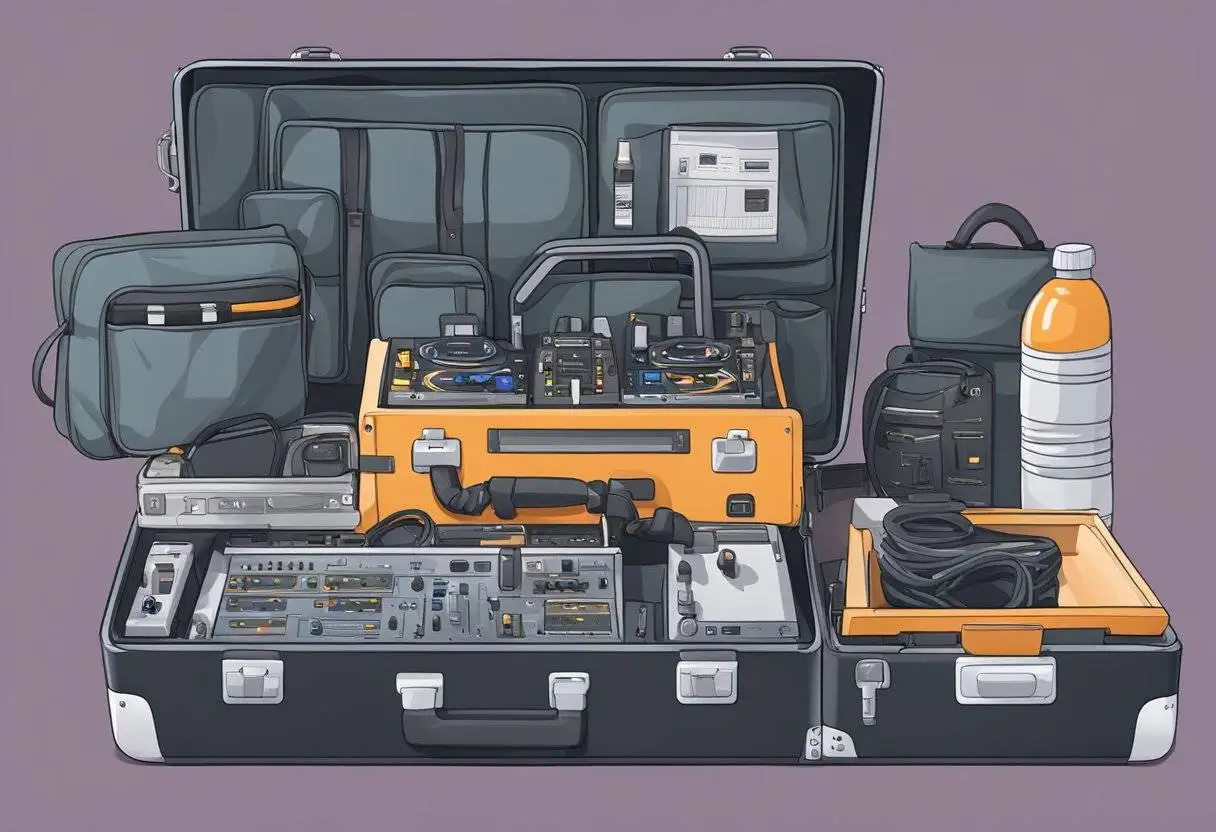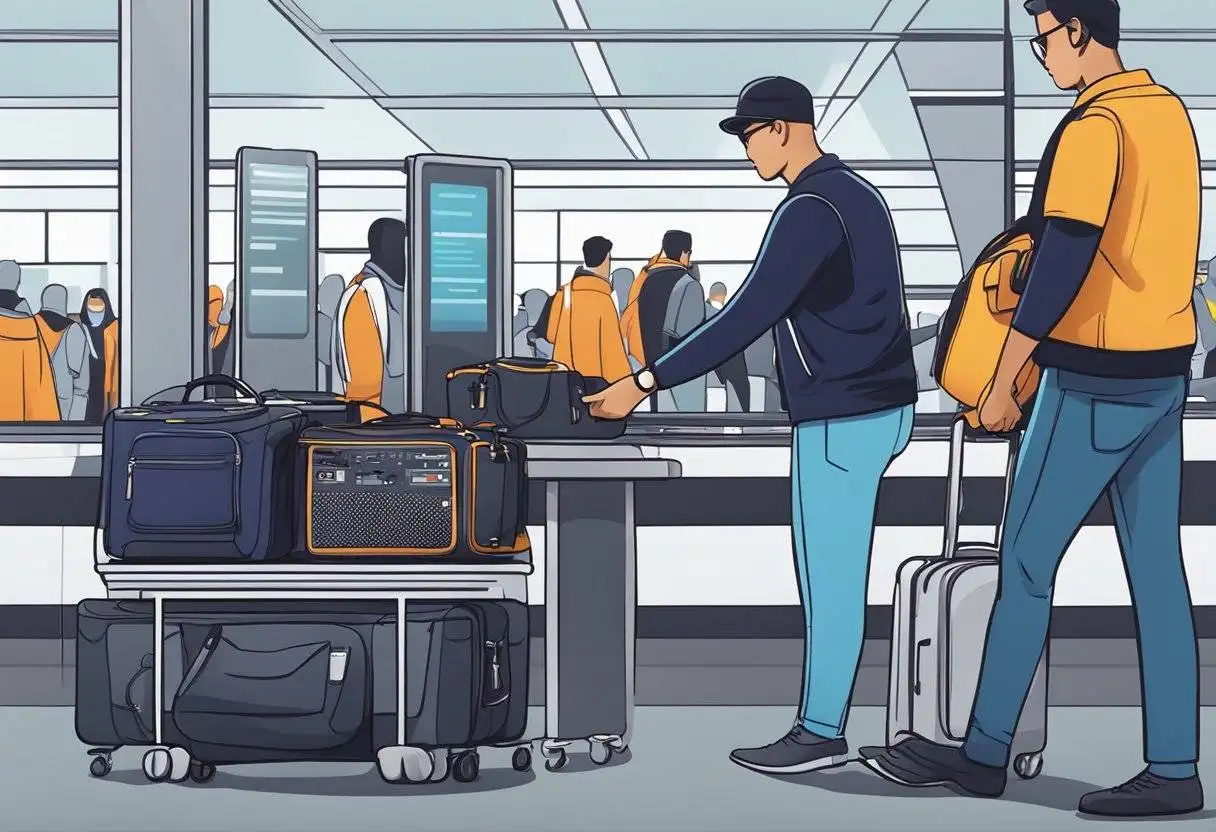Traveling with DJ equipment on a plane is definitely possible, and I understand that as a DJ, keeping your gear safe during transit is a priority. Traditional airline baggage policies can be navigated to accommodate the unique needs of transporting such equipment. Both carry-on and checked baggage options are available for equipment such as mixers, controllers, and headphones, provided they meet airline size and weight specifications.

I’m aware that the specifics may vary by airline, and often, instruments and professional equipment receive some leeway. While the standard international carry-on dimensions are generally 21″ x 14″ x 9″ and the standard weight is 15lbs, certain airlines may allow for larger musical items to be checked in. It’s crucial to be well informed about each airline’s policy, as some might have different requirements or provide special considerations for DJ equipment.
Checking the Transportation Security Administration (TSA) guidelines before flying can also serve as a good baseline of what to expect at security checks. Moreover, being courteous with the airline staff can greatly improve the likelihood of having a smooth experience. Through preparation and communication with your chosen airline, you can ensure that your DJ equipment travels as smoothly as your music.
Preparing DJ Equipment for Air Travel
Before you head to the airport, ensure you are well versed with the airline’s policies and your equipment is packed securely for the journey.
Assessing Airline Policies and Regulations
Each airline has specific rules regarding the transport of DJ equipment. It’s essential to check with your chosen carrier for their size and weight restrictions for both carry-on and checked baggage. For example, DJ controllers might be considered musical instruments, allowing for different handling. It is crucial to know if you need to purchase an extra seat for oversized items or if you can include them within your standard luggage allowance. Airlines also have guidelines about fragile items, which affects how your equipment will be treated during handling.
Packing Guidelines for DJ Gear
The right packing is fundamental to protecting your DJ gear during transit. Use flight cases or controller backpacks designed for travel, ensuring they can withstand physical inspection and the rigors of being in the cargo area of a plane. Internal padding and bubble wrap can offer additional protection for delicate items like mixers and hard drives. Always label your gear as fragile and keep cables, flash drives, and DJ headphones easily accessible for security checks. Remember to follow TSA guidelines for electronic items and liquids.
Carrying On vs. Checking In DJ Equipment
When choosing between carrying on and checking in your DJ equipment, consider the aircraft size requirements and your comfort level with risk. Carry-on luggage should fit in the overhead bin or under the seat in front of you, usually in an upright position. Checked baggage will go through more handling, so robust flight cases are a must. Renting equipment from reputable rental companies at your destination is an option if you want to avoid the hassle. Lastly, look into travel insurance to cover your gear for additional peace of mind.
When I fly with DJ equipment, understanding specific TSA guidelines and preparing properly for security screening are paramount to a smooth experience at the airport. Here’s how I handle each step:
Understanding TSA Guidelines for Electronics
Per TSA regulations, all electronic devices larger than a smartphone, such as laptops and some components of DJ equipment, need to be removed from carry-on luggage and placed in separate bins for X-ray screening. I ensure to check the TSA guidelines for the most up-to-date information on traveling with electronics. For larger items that can’t be scanned, I anticipate potential physical inspection.
Preparing for Security Screening
Preparation is key to ensuring my equipment goes through security as smoothly as possible. Here’s a brief checklist I follow:
Electronics Checklist:
- Make sure all electronic items are easily accessible.
- Double-check weight and dimensions comply with carry-on restrictions.
- Charge all devices—security may require them to be powered on for inspection.
Packing Tips:
- Use padded bags for extra protection.
- Label all equipment with contact information.
- Keep cables tidy and separate from the equipment for a quick scan process.
At the security checkpoint, I’m polite and cooperative, as a good rapport with TSA agents can facilitate a smoother process. I stay alert and watch my items until they’re cleared and safely repacked after the security check.
Protecting Your DJ Equipment during Transit
When I travel with my DJ equipment, ensuring its protection is my top priority. This section covers the essential steps I take to safeguard my gear.
Selecting the Right Cases and Covers
I always opt for a flight case when the equipment needs to check in, as they offer a robust layer of protection. These cases are typically made from durable materials like aluminum and feature reinforced corners. For extra cushioning, I line the interior with bubble wrap or foam. If my gear is particularly fragile, I make sure the case is labeled as such, and I inform the airline ahead of time for special care.
For carry-on luggage, I use padded sleeve bags or a decksaver cover that snuggly fits around my equipment. These covers are especially useful for preventing scratches or dents on the more delicate controls. I ensure that my carry-on bags fit within the cabin’s dimensions and weight restrictions specified by the airline.
Ensuring Equipment Safety on Board
On board, I take a hands-on approach to ensure the safety of my equipment. I prefer to store my gear in the overhead compartment directly above my seat, where it’s within my sight at all times. When placing it in the bin, I make sure that other passengers do not stack their bags on top of mine, as the pressure could cause damage. If my equipment must be checked, I opt for a hard drive designed to withstand handling during flight. I alert the crew that my luggage is fragile, reinforcing the need for careful transport.
Considering Additional Aspects of DJ Equipment Travel

When I travel with my DJ equipment, I have to think about more than just getting it on the plane. I consider insurance in case of loss or damage, and I’m mindful of power requirements, especially for international gigs.
Insurance and Liability Coverage
Before I depart, insurance is a priority. I opt for travel insurance that specifically covers my DJ equipment to mitigate any potential losses in transit. It’s not just about damage—although I’ve been lucky so far—it’s about theft or misplacement as well. I make it a point to understand the terms of coverage and document my kit‘s condition before flights.
International Travel and Voltage Considerations
Voltage can be tricky in different countries, so I always check the voltage specifications of my equipment against the standards of my destination. Being prepared means bringing adapters and voltage converters if necessary. For international flights, researching ahead of time saves me the headache of incompatible outlets.
Sometimes, renting gear from local rental companies is more practical. This not only ensures I have the right voltage for my lights and kit but it also immerses me in the local culture—I get to work with what local DJs use, and that’s been an amazing way to learn and adapt.
Frequently Asked Questions

When traveling with DJ equipment on a plane, understanding airline and security regulations is crucial to ensure a smooth journey. My experience can help clarify these specifics.
Are there specific airline regulations for carrying DJ controllers as hand luggage?
Yes, airlines typically have specific dimensions and weight limits for carry-on luggage, which apply to DJ controllers. It’s best to check with the specific airline, as the default international dimensions are generally 21″ x 14″ x 9″ with a weight limit of 15lbs.
What is the process for bringing a full DJ setup on a flight?
Transporting a full DJ setup requires prior coordination with the airline. I usually secure my equipment in protective cases and verify if any part of my setup needs to be checked due to size or weight restrictions. Sometimes airlines allow certain items as carry-on or in checked baggage, but it is essential to check beforehand.
How do you pack mixers and turntables for checked airline baggage?
I ensure that mixers and turntables are packed in flight cases or padded bags designed for musical instruments. I often add additional padding, and I always insure my gear as it will be handled as checked baggage.
Can portable DJ equipment be brought onto a plane without additional charges?
Most portable DJ equipment can be brought onto a plane without additional charges as long as it complies with the airline’s carry-on size and weight restrictions. It’s always recommended to check with the airline to avoid any unexpected fees.
What are the TSA guidelines for traveling with electronic music equipment?
The TSA requires that all electronic music equipment be screened, and sometimes a physical inspection is necessary. I recommend arriving at the airport early to accommodate any additional screening time.
Do airlines require special handling for fragile instruments like turntables?
Yes, airlines typically require special handling for fragile instruments. I always label my equipment as fragile and discuss the need for special handling at the check-in counter, to ensure that my turntables and other sensitive items receive the appropriate care.
